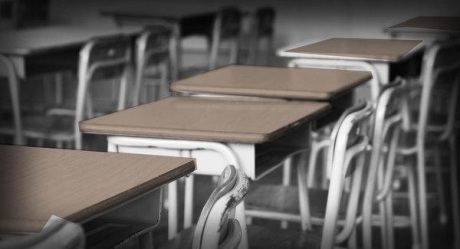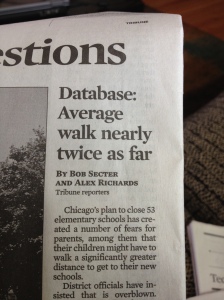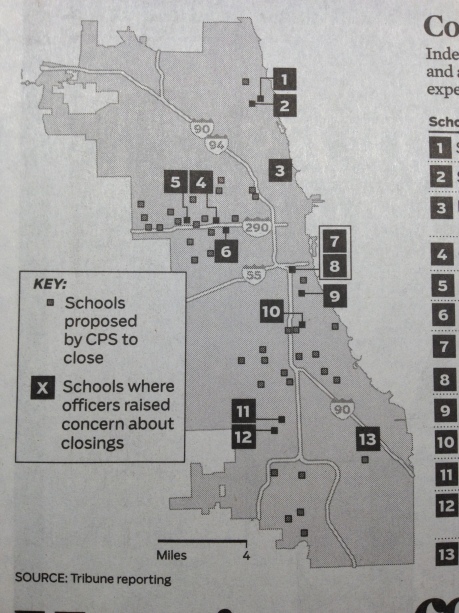Schools are being closed in American cities.
Philadelphia. Newark. Washington. Chicago. Detroit.
They say schools are being closed for good reasons. Money. Underperformance. Money. Shifting populations. Money.
I’m $ure a good ca$e can be made for the$e rea$on$.
But what else is happening as urban schools close?
Schools in poorer and minority neighborhoods are disproportionately being closed. Since 2001 Chicago has closed 100, all but two in poor neighborhoods. 88% of affected students have been African-American.
There is no arguing with the sharp pencils. Population shifts. Deficits.
A couple weeks ago we returned home to a pile of newspapers. I hadn’t stopped delivery. But I had some time today to catch up on reading. Internet is good but I like to hold sheets of newsprint, to leisurely page back and forth through them. Tactile satisfaction. Newspaper also forms a nap inducing warm quiet micro-environment when placed over and around one’s head. Try it.
At the top of one Chicago Tribune front page “CPS closes in on school cuts … anxiety grows as district offers preliminary list of 129 campuses that could be shuttered“. It hardly seems news anymore to hear of large urban school districts closing schools, increasing the ratio of students to teacher. We just accept it as a way of life.
But what caught my attention was the map showing areas of the city where schools may be closed. I can’t get the Chi Trib graphics article to appear. So here’s my elegant low/high tech solution: an iPhone photo of the paper –

Compare this map with Open City’s Chicago Public Schools Tiers where areas of Chicago are identified as one of four Tiers. Tier 1 are places where people tend to “make less money and have less education”. Tier 4 would be where people “make more money and have more education”.
Guess which Tier will overwhelmingly lose more schools? Tier 1 or Tier 4? That wasn’t hard.
Okay. The areas about to lose schools are areas with less and less children, according to the authorities. But these same areas are also home to children living in the least educated and lowest income households in Chicago.
If most of the CPS school closings take place in Tier 1 neighborhoods, it will have an even greater impact than a closing in a Tier 4. If a neighborhood school closes, parents do not believe it will mean a better education for their children. My child may be assigned to a school with a better building, a greater concentration of teacher and material resources. But she will need to travel farther. Be in an unfamiliar place. Increase the likelihood of running into hostility. Gangs? Regardless of promises, who is ahead when my neighborhood no longer has a school?
Distribution of wealth, of education resources, will be to the most populous neighborhoods of Chicago. That seems sensible. But it will also mean a more challenging, harder experience for the poorest children, for the children who already face the greatest hurdles in becoming educated.
I see this as an issue of justice. In its desire to solve one problem by making the education system more efficient and effective, the solution will contribute to another problem. Chicago will continue to offer swaths of the city where hopelessness is cultivated in an increasingly entrenched population of undereducated Chicagoans.
If Chicago continues to close schools in its poorest neighborhoods, is this justice?
Maybe Chicago will have more and more of its citizzzens who find napping to be the best use of a newspaper.












